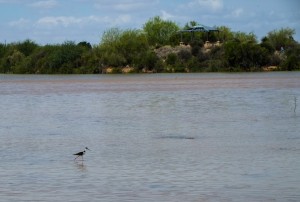
Black-necked stilt, Gilbert Water Ranch
When I’m in Phoenix, I always try to squeeze out some time to go birding at the Gilbert Water Ranch, a constructed wetland where practical water management has been turned into a lovely urban amenity.
A fascinating new project by Arizona State University graduate student Riley Burnette (pdf) attempts to quantify the role that the greater Phoenix metro area’s urban water plays as water bird habitat.
Yes, Phoenix is apparently a water bird hot spot!
Cities within the arid Southwest often act as a mesic relief to the dry surrounding habitats, offering similar resources as the natural riparian strips waterbirds have traditionally been shown to use. In desert cities, waterbirds have the potential to use the 6 large amount of aquatic resources provided by the reallocation and distribution of water. In Phoenix, the Arizona Game and Fish Department has been conducting a waterbird census since 2006 and determined that numerous urban water-bodies attract a proportionally higher diversity and abundance of waterbirds than anywhere else in Arizona.
This is often accidental, but Burnette argues that this presents management opportunities:
Urban riparian areas are often a direct interface between humans and nature, and can catalyze socioeconomic and ecological revitalization of cities…. A combination of aquatic features can provide a number of ecosystems services, including 65 increased biodiversity, and a better understanding of the system will allow for managers to direct decisions for desired outcomes.
One of the implications here is that water conservation, often an unquestioned goal (by me!), has implications for urban ecosystems:
It is interesting to consider some of the potential outcomes if the “leakiness” of stormdrains are improved or the amount of public water is reduced…. As water conservation becomes increasingly important…, there must be awareness that water is a multi-faceted resource with the potential to optimize habitat and support biodiversity in addition to providing public services….

This is challenge with agriculture as well, and the Salton Sea in particular: increasing irrigation efficiency leads directly to decreased run-off, the very water that sustains the Salton Sea. This is not a plea to preserve waste, but rather to optimize the water inputs to these unintentional systems. Properly managed, dramatically less water into the Salton Sea (and into other systems) can still sustain tremendous ecological value. While not the classic wilderness view of untouched, undisturbed “nature,” the birds generally don’t care (as the excerpts from Burnette’s thesis show).
Thanks! I learned a new word: mesic
(of an environment or habitat) containing a moderate amount of moisture.
I assume the (Arabic- would Rep. Steve King accept that?) numbers were footnote numbers in the original?